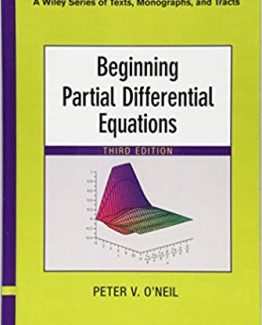Elementary Linear Algebra: Applications Version 12th Edition by Howard Anton, ISBN-13: 978-1119406723
[PDF eBook eTextbook]
- Publisher: Wiley; 12th edition (February 20, 2019)
- Language: English
- 800 pages
- ISBN-10: 9781119406723
- ISBN-13: 978-1119406723
Elementary Linear Algebra: Applications Version, 12th Edition gives an elementary treatment of linear algebra that is suitable for a first course for undergraduate students. The aim is to present the fundamentals of linear algebra in the clearest possible way; pedagogy is the main consideration. Calculus is not a prerequisite, but there are clearly labeled exercises and examples (which can be omitted without loss of continuity) for students who have studied calculus.
Table of Contents:
Cover
Table of Contents
Applications and Historical Topics
Title Page
Copyright
Dedication
About the Authors
Preface
CHAPTER 1: Systems of Linear Equations and Matrices
CHAPTER CONTENTS
Introduction
1.1 Introduction to Systems of Linear Equations
1.2 Gaussian Elimination
1.3 Matrices and Matrix Operations
1.4 Inverses; Algebraic Properties of Matrices
1.5 Elementary Matrices and a Method for Finding A
1.6 More on Linear Systems and Invertible Matrices
1.7 Diagonal, Triangular, and Symmetric Matrices
1.8 Introduction to Linear Transformations
1.9 Compositions of Matrix Transformations
1.10 Applications of Linear Systems
1.11 Leontief Input‐Output Models
Chapter 1 Supplementary Exercises
CHAPTER 2: Determinants
CHAPTER CONTENTS
Introduction
2.1 Determinants by Cofactor Expansion
2.2 Evaluating Determinants by Row Reduction
2.3 Properties of Determinants; Cramer’s Rule
Chapter 2 Supplementary Exercises
CHAPTER 3: Euclidean Vector Spaces
CHAPTER CONTENTS
Introduction
3.1 Vectors in 2‐Space, 3‐Space, and n‐Space
3.2 Norm, Dot Product, and Distance in Rn
3.3 Orthogonality
3.4 The Geometry of Linear Systems
3.5 Cross Product
Chapter 3 Supplementary Exercises
CHAPTER 4: General Vector Spaces
CHAPTER CONTENTS
Introduction
4.1 Real Vector Spaces
4.2 Subspaces
4.3 Spanning Sets
4.4 Linear Independence
4.5 Coordinates and Basis
4.6 Dimension
4.7 Change of Basis
4.8 Row Space, Column Space, and Null Space
4.9 Rank, Nullity, and the Fundamental Matrix Spaces
Chapter 4 Supplementary Exercises
CHAPTER 5: Eigenvalues and Eigenvectors
CHAPTER CONTENTS
Introduction
5.1 Eigenvalues and Eigenvectors
5.2 Diagonalization
5.3 Complex Vector Spaces
5.4 Differential Equations
5.5 Dynamical Systems and Markov Chains
Chapter 5 Supplementary Exercises
CHAPTER 6: Inner Product Spaces
CHAPTER CONTENTS
Introduction
6.1 Inner Products
6.2 Angle and Orthogonality in Inner Product Spaces
6.3 Gram–Schmidt Process; QR‐Decomposition
6.4 Best Approximation; Least Squares
6.5 Mathematical Modeling Using Least Squares
6.6 Function Approximation; Fourier Series
Chapter 6 Supplementary Exercises
CHAPTER 7: Diagonalization and Quadratic Forms
CHAPTER CONTENTS
Introduction
7.1 Orthogonal Matrices
7.2 Orthogonal Diagonalization
7.3 Quadratic Forms
7.4 Optimization Using Quadratic Forms
7.5 Hermitian, Unitary, and Normal Matrices
Chapter 7 Supplementary Exercises
CHAPTER 8: General Linear Transformations
CHAPTER CONTENTS
Introduction
8.1 General Linear Transformations
8.2 Compositions and Inverse Transformations
8.3 Isomorphism
8.4 Matrices for General Linear Transformations
8.5 Similarity
8.6 Geometry of Matrix Operators
Chapter 8 Supplementary Exercises
CHAPTER 9: Numerical Methods
CHAPTER CONTENTS
Introduction
9.1 LU‐Decompositions
9.2 The Power Method
9.3 Comparison of Procedures for Solving Linear Systems
9.4 Singular Value Decomposition
9.5 Data Compression Using Singular Value Decomposition
Chapter 9 Supplementary Exercises
CHAPTER 10: Applications of Linear Algebra
CHAPTER CONTENTS
Introduction
10.1 Constructing Curves and Surfaces Through Specified Points
10.2 The Earliest Applications of Linear Algebra
10.3 Cubic Spline Interpolation
10.4 Markov Chains
10.5 Graph Theory
10.6 Games of Strategy
10.7 Forest Management
10.8 Computer Graphics
10.9 Equilibrium Temperature Distributions
10.10 Computed Tomography
10.11 Fractals
10.12 Chaos
10.13 Cryptography
10.14 Genetics
10.15 Age‐Specific Population Growth
10.16 Harvesting of Animal Populations
10.17 A Least Squares Model for Human Hearing
10.18 Warps and Morphs
10.19 Internet Search Engines
10.20 Facial Recognition
Appendix A: Working with Proofs
Appendix B: Complex Numbers
Index
What makes us different?
• Instant Download
• Always Competitive Pricing
• 100% Privacy
• FREE Sample Available
• 24-7 LIVE Customer Support






Reviews
There are no reviews yet.